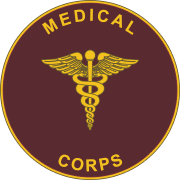U.S. Army Medical Corps
| United States Army Medical Corps |
|
|---|---|

The U.S. Army Medical Corps
Branch Plaque. |
|
| Active | 1908 – present day |
| Country |
|
| Branch |
|
The Medical Corps (MC) of the U.S. Army is a staff corps (non-combat specialty branch) of the U.S. Army Medical Department (AMEDD) consisting of commissioned medical officers – physicians with either an M.D. or a D.O. degree, at least one year of post-graduate clinical training, and a state medical license.
The MC traces its earliest origins to the first physicians recruited by the Medical Department of the Army, created by the Continental Congress in 1775. The US Congress made official the designation "Medical Corps" in 1908, although the term had long been in use informally among the Medical Department's regular physicians.
Currently, the MC consists of over 4,400 active duty physicians representing all the specialties and subspecialties of civilian medicine. They may be assigned to fixed military medical facilities, to deployable combat units or to military medical research and development duties. They are considered fully deployable soldiers. The Chief of the Medical Corps Branch (under the Army's Human Resources Command) is a colonel and the senior-most Medical Corps officer in the Army is the U.S. Army Surgeon General, a lieutenant general.
Both the Army Medical Department and the Medical Corps trace their origins to 27 July 1775, when the Continental Congress established the first Army Hospital to be headed by a "Director General and Chief Physician". The language of the Congressional resolution spoke of “an Hospital” which in those days meant a hospital system or medical department. Among the accomplishments of Army surgeons during the years of the Revolution was completion (in 1778, at Lititz, Pennsylvania) of the first pharmacopoeia printed in America. In 1789, the Department of the Hospital was disbanded and a system of "Regimental Surgeons" was established in its place.
...
Wikipedia
